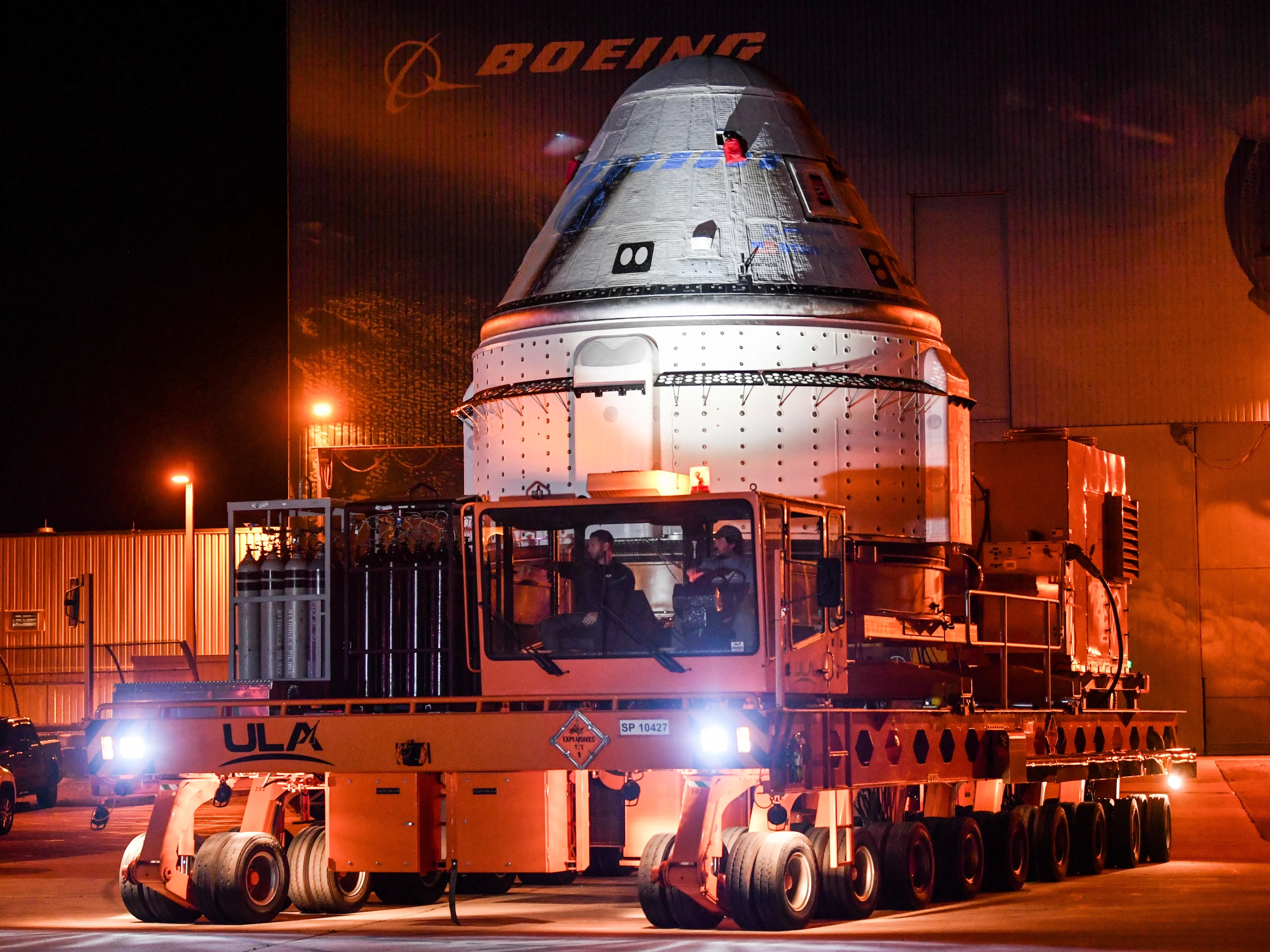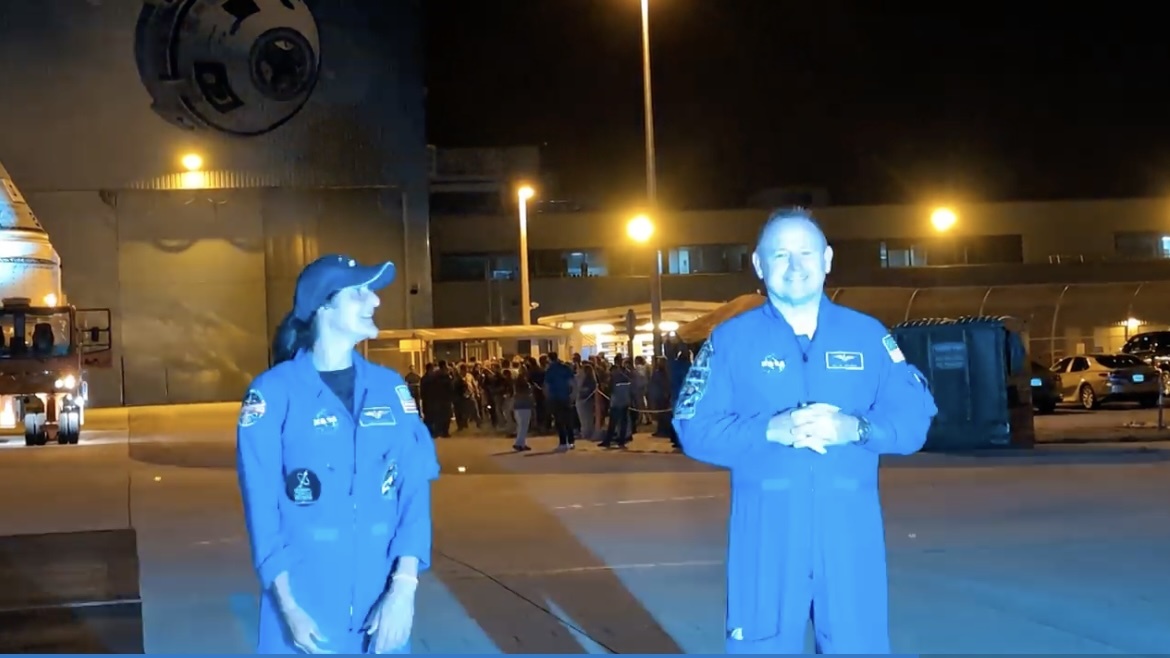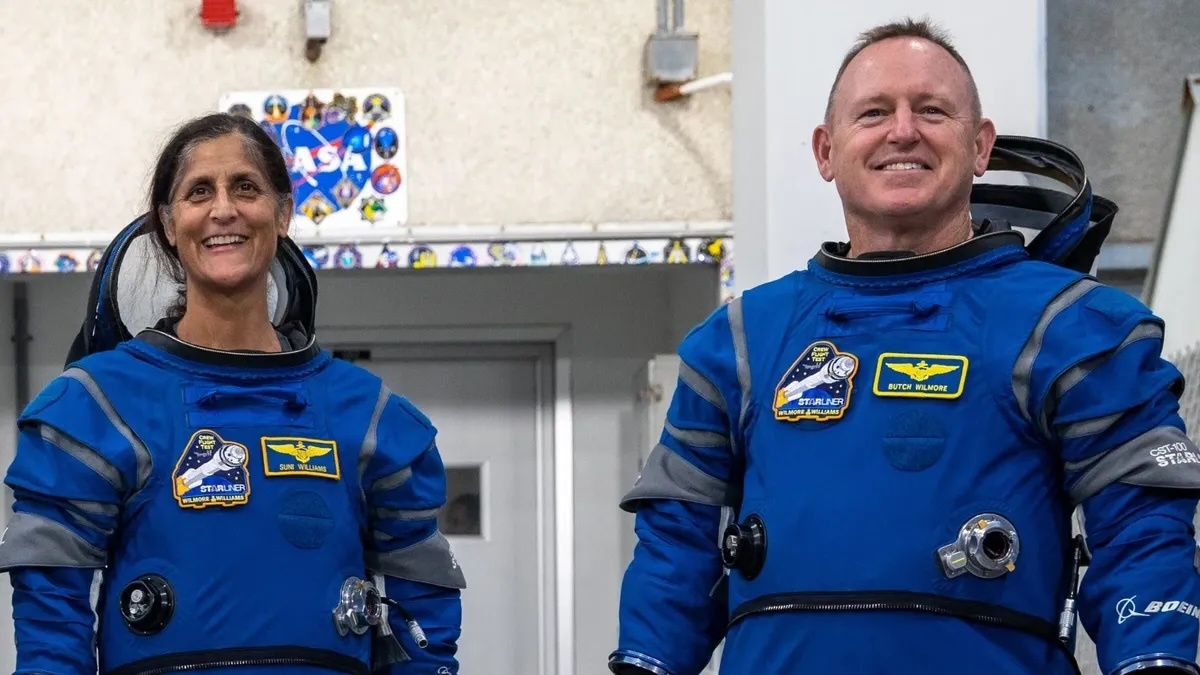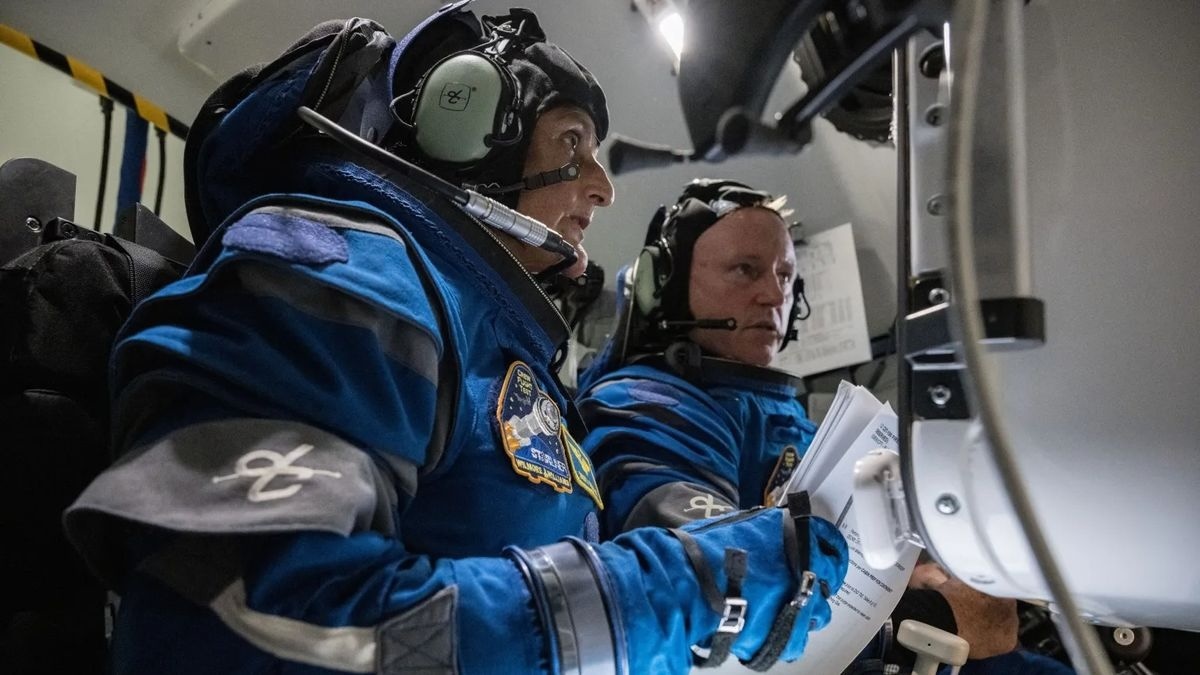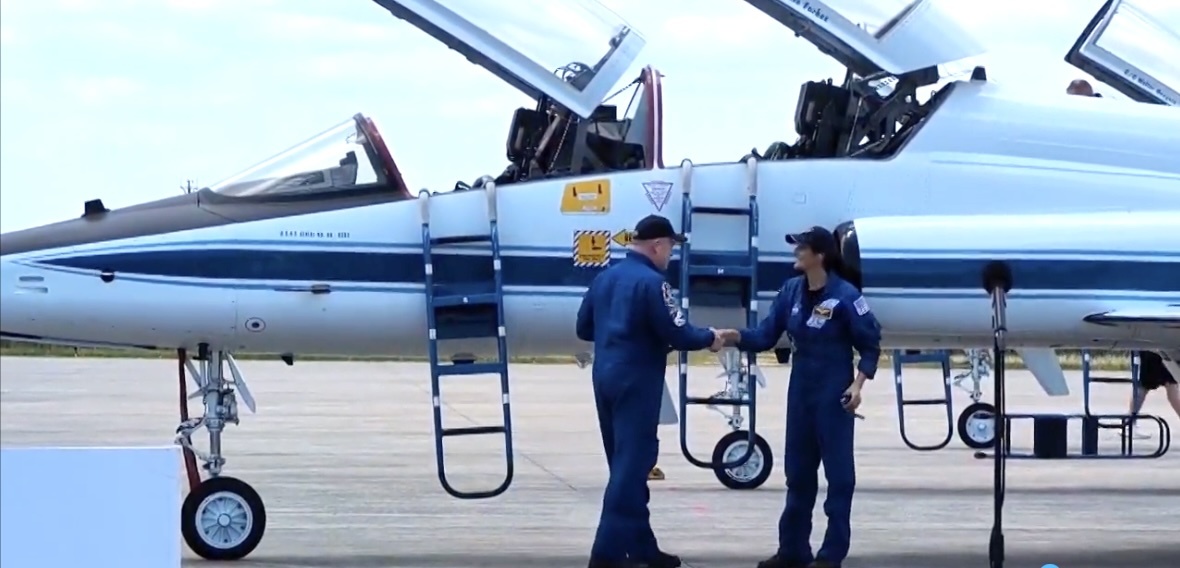NASA Sets Coverage for Boeing Starliner’s First Crewed Launch, Docking
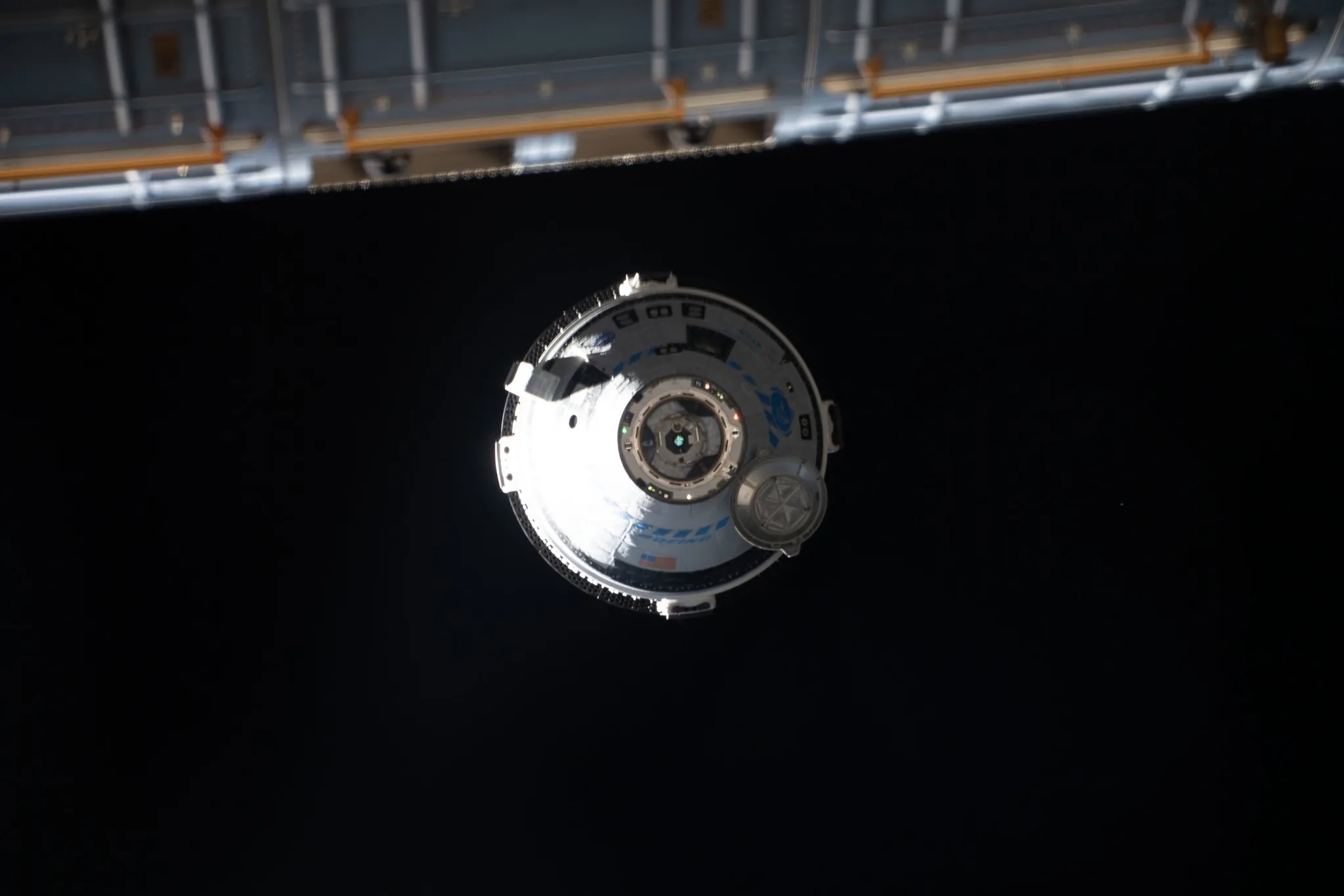
NASA will provide live coverage of prelaunch and launch activities for the agency’s Boeing Crew Flight Test, which will carry NASA astronauts Butch Wilmore and Suni Williams to and from the International Space Station.
Launch of the ULA (United Launch Alliance) Atlas V rocket and Boeing Starliner spacecraft is targeted for 10:34 p.m. EDT Monday, May 6, from Space Launch Complex-41 at Cape Canaveral Space Force Station in Florida.
The flight test will carry Wilmore and Williams to the space station for about a week to test the Starliner spacecraft and its subsystems before NASA certifies the transportation system for rotational missions to the orbiting laboratory for the agency’s Commercial Crew Program.
Starliner will dock to the forward-facing port of the station’s Harmony module at 12:48 a.m., Wednesday, May 8.
The deadline for media accreditation for in-person coverage of this launch has passed. The agency’s media credentialing policy is available online. For questions about media accreditation, please email: ksc-media-accreditat@mail.nasa.gov.
NASA’s mission coverage is as follows (all times Eastern and subject to change based on real-time operations):
Wednesday, May 1
1:30 p.m. – Virtual news conference at Kennedy with the flight test astronauts:
- NASA astronaut Butch Wilmore
- NASA astronaut Suni Williams
Coverage of the virtual news conference will stream live on NASA+, NASA Television, the NASA app, YouTube, and the agency’s website.
Media may ask questions via phone only. For the dial-in number and passcode, please contact the Kennedy newsroom no later than 12:30 p.m., Wednesday, May 1, at: ksc-newsroom@mail.nasa.gov.
Friday, May 3
12:30 p.m. – Prelaunch news conference at Kennedy (no earlier than one hour after completion of the Launch Readiness Review) with the following participants:
- NASA Administrator Bill Nelson
- Steve Stich, manager, NASA’s Commercial Crew Program
- Dana Weigel, manager, NASA’s International Space Station Program
- Emily Nelson, chief flight director, NASA
- Jennifer Buchli, chief scientist, NASA’s International Space Station Program
- Mark Nappi, vice president and program manager, Commercial Crew Program, Boeing
- Gary Wentz, vice president, Government and Commercial Programs, ULA
- Brian Cizek, launch weather officer, 45th Weather Squadron, Cape Canaveral Space Force Station
Coverage of the prelaunch news conference will stream live on NASA+, NASA Television, the NASA app, YouTube, and the agency’s website.
Media may ask questions in person and via phone. Limited auditorium space will be available for in-person participation. For the dial-in number and passcode, media should contact the Kennedy newsroom no later than 11:30 a.m., Friday, May 3, at ksc-newsroom@mail.nasa.gov.
3:30 p.m. – NASA Social panel live stream event at Kennedy with the following participants:
- NASA Associate Administrator Jim Free
- Ian Kappes, deputy launch vehicle office manager, NASA’s Commercial Crew Program
- Amy Comeau Denker, Starliner associate chief engineer, Boeing
- Caleb Weiss, system engineering and test leader, ULA
- Jennifer Buchli, chief scientist, NASA’s International Space Station Program
Coverage of the panel live stream event will stream live at @NASAKennedy on YouTube, @NASAKennedy on X, and @NASAKennedy on Facebook. Members of the public may ask questions online by posting questions to the YouTube, X, and Facebook livestreams using #AskNASA.
Monday, May 6
6:30 p.m. – Launch coverage begins on NASA+, NASA Television, the NASA app, YouTube, and the agency’s website.
10:34 p.m. – Launch
Launch coverage on NASA+ will end shortly after Starliner orbital insertion. NASA Television will provide continuous coverage leading up to docking and through hatch opening and welcome remarks.
Tuesday, May 7
12 a.m. – Postlaunch news conference with the following participants:
- NASA Deputy Administrator Pam Melroy
- Ken Bowersox, associate administrator, NASA’s Space Operations Mission Directorate
- Steve Stich, manager, NASA’s Commercial Crew Program
- Dana Weigel, manager, NASA’s International Space Station Program
- Mark Nappi, vice president and program manager, Commercial Crew Program, Boeing
- Gary Wentz, vice president, Government and Commercial Programs, ULA
Coverage of the postlaunch news conference will air live on NASA+, NASA Television, the NASA app, YouTube, and the agency’s website.
NASA+ will resume coverage and NASA Television’s media channel will break from in-orbit coverage to carry the postlaunch news conference. Mission operational coverage will continue on NASA Television’s public channel and the agency’s website. Once the postlaunch news conference is complete, NASA+ coverage will end, and mission coverage will continue on both NASA channels.
Media may ask questions in person and via phone. Limited auditorium space will be available for in-person participation. For the dial-in number and passcode, media should contact the Kennedy newsroom no later than 10:30 p.m., Monday, May 6, at ksc-newsroom@mail.nasa.gov.
10:15 p.m. – Arrival coverage resumes on NASA+, the NASA app, and YouTube, and continues on NASA Television and the agency’s website.
Wednesday, May 8
12:48 a.m. – Targeted docking to the forward-facing port of the station’s Harmony module
2:35 a.m. – Hatch opening
3:15 a.m. – Welcome remarks
4:15 a.m. – Post-docking news conference at Johnson with the following participants:
- NASA Associate Administrator Jim Free
- Steve Stich, manager, NASA’s Commercial Crew Program
- Dana Weigel, manager, NASA’s International Space Station Program
- Mark Nappi, vice president and program manager, Commercial Crew Program, Boeing
Coverage of the post-docking news conference will air live on NASA+, NASA Television, the NASA app, YouTube, and the agency’s website.
All times are estimates and could be adjusted based on operations after launch. Follow the space station blog for the most up-to-date operations information.
Quelle: NASA
----
Update: 6.05.2024
.
Boeing Starliner is set to launch NASA astronauts from Florida on the Crewed Flight Test

Monday promises to be a day of firsts.
The first crewed flight of Boeing's Starliner spacecraft, the latest private vehicle to be ready to carry American astronauts into low Earth orbit. The first time an Atlas V rocket has lifted astronauts into space. The first launch of humans from Cape Canaveral Space Force Station's Launch Complex 41.
But on a day of firsts, there is one thing that's not: the two NASA astronauts flying Starliner to the International Space Station bring with them extensive experience in space and at the orbiting outpost. Astronaut Sunita "Suni" Williams, the Starliner pilot, described the mission last week as "feeling like going home."
Williams and fellow astronaut Butch Wilmore , the mission commander, share Navy test pilot backgrounds and both have flown on two NASA missions to the station. Both have been training years for this flight, as they waited through multiple delays. The Starliner, like SpaceX's Dragon, is being contracted by NASA to ferry crews to-and-from the ISS.
"Because it is a test flight, we give extra attention ... they are checking out a lot of the systems, the life support, the manual control, all of those things that you want to be checked out," said NASA Administrator Bill Nelson at a Friday news conference. "That's why we put two test pilots onboard."
The Starliner capsule is set to launch atop the United Launch Alliance Atlas V rocket on the Crewed Flight Test mission at 10:34 p.m. Monday from Cape Canaveral Space Force Station's Launch Complex 41. The early weather outlook appears good with a 95 percent chance of acceptable conditions for launch.
"We’re at peak performance right now and we’re really looking forward to executing this weekend, executing the launch and executing the mission in the same way that we got here," said Mark Nappi, vice president and program manager for Boeing's Starliner program. "We’re ready to go."
Here’s everything you need to know about the mission.
Starliner will launch from Space Force Launch Complex 41 at Cape Canaveral.
The pad has been the launch site for historic missions beginning with the Titan rockets in 1965. Other notable missions include the New Horizons deep space probe, the Voyager spacecraft and even the Curiosity Mars rover.
What has never happened from the pad before: the launch of humans. The Atlas V rocket has launched from the site since 2002, but this will be the first time it carries astronauts to space.
To prepare for this mission, the launch complex recently saw the addition of a crew access arm.
Another interesting note: the last crewed launch from this military side of the Cape occurred in 1968 with the launch of Apollo 7. All other crewed launches since have taken place from Kennedy Space Center.
Also, this will be only the sixth time in history NASA astronauts have flown a new spacecraft. These include: Mercury, Gemini, Apollo, Space Shuttle, Dragon, and now Starliner.
Role of Boeing Starliner in NASA's Commercial Crew Program
The day the Starliner spacecraft was finally mated to the United Launch Alliance Atlas V rocket for the crew flight test was a long time coming for the team at Boeing.
NASA originally awarded Boeing the contract to fly astronauts in 2014, alongside SpaceX. Boeing received $4.8 billion for Starliner while SpaceX received $3.1 billion for Dragon. Both companies were part of NASA's Commercial Crew Program, which replaced the space shuttle after its retirement in 2011.
Both were late to deliver, hoping to launch as soon as 2017 and restore NASA astronauts access to space from American soil (NASA astronauts were hitching rides aboard the Russian Soyuz).
Following a successful crewed demo flight in 2020, SpaceX has since flown eight NASA crews and multiple private crews to the ISS.
After facing multiple setbacks, including issues found after a successful uncrewed docking with the ISS and landing in 2022, Boeing hopes to prove the capability of its Starliner spacecraft to take on its designated role ferrying NASA crews to the station.
Once successful, Starliner will fly NASA crews in rotation with SpaceX's Dragon− a needed redundancy to ensure NASA access to low Earth orbit.
Going beyond this test flight, according to Boeing, NASA has already contracted for six crewed missions on Starliner.
NASA astronaut and former NASA Associate Administrator and former KSC Director Bob Cabana told FLORIDA TODAY that the success of Boeing Starliner is essential to ensure NASA always has a way to access the station.
“We want that dissimilar redundancy,” said Cabana, adding that NASA cannot rely on solely one company.
With the commercial crew program charged with ensuring access to low Earth orbit, NASA continues to work on its Artemis program, which will fly a crew around the Moon as soon as late 2025. That will mark the first time humans have returned to the Moon since the Apollo missions ended over five decades ago.
NASA's confidence in Starliner
FLORIDA TODAY spoke with Kim Ess, manager of the Integrated Performance Office (IPO) in NASA’s Commercial Crew Program (CCP) at Johnson Space Center. Ess explained that NASA has done demonstration testing alongside Boeing to ensure the safety of the spacecraft.
"We took more risks when it was just a test flight," Ess said on the topic of the second uncrewed flight in 2022. "Now that our payload, our two crew members, Butch and Suni, we did a lot more research."
She explained that NASA provided Boeing requirements to meet before this crewed flight, and Boeing returned with the necessary results.
"In many cases, we do an independent verification of those requirements," Ess said. She used the example of Boeing demonstrating that they would be able to return the crew safely during a simulation of the landing. NASA ran the same simulation at the organization's Johnson Space Center to compare the data.
"Any differences, we bring in and we talk with them and see 'okay, did you have an error in your model, or did we have an error in our model, or are these true differences?'" Ess said.
"As long as they're along the same lines, we're good. And we have done that extensively for this flight," Ess said.
What is the Starliner spacecraft?
Boeing calls it the Crew Space Transportation (CST)-100 Starliner, or simply “Starliner”. Like SpaceX's Crew Dragon, it can carry a mix of crew and cargo or up to seven crew memebers.
With a total height of 16.5 ft (capsule + service module combined) and a diameter of 15 ft, it is a what Boeing refers to as "a next-generation space capsule."
This Starliner spacecraft has a name
The capsule flying Monday was named Calypso by Williams.
Williams, a lover of the ocean, has stated in the past that she named the spacecraft Calypso after the ship of Jacque Cousteau, which was an ocean explorer in the mid-20th century.
That ship was remembered for its underwater observation chamber and being equipped with a helicopter and submersibles, assisting in scientific expeditions. Williams mentioned being excited by Cousteau's television show as a young girl and looked forward to watching his expeditions.
Williams has a special connection to Brevard County
After gaining a B.S. in Physical Science from the U.S. Naval Academy, Williams graduated from Florida Tech in 1995 with her M.S. in Engineering Science.
Last year, she gave a commencement speech to the 2023 Florida Tech graduates.
Williams' first chance to fly to space came when assigned to STS-116. On December 9, 2006, Williams and crew took off onboard Space Shuttle Discovery for a six month stay onboard the ISS.
Williams returned to the ISS during Expedition 32/33. Launching from Kazakhstan in a Soyuz spacecraft on July 14, 2012, Williams saw another long stay onboard the space station. After that 127-day visit to space, she accumulated a total of 322 days spent off the planet.
Now, she said, she's been waiting a long time for this moment.
"With each launch that was rescheduled, I've been given perspective I would've never had without those delays," Williams said before going on to explain how the crew not only got more time to learn about the spacecraft, but to also help shape the Starliner program.
The Starliner crew's playlist and ride to the pad
During a preflight NASA Q and A, Wilmore and Williams mentioned the new Astro Van. Unlike SpaceX crews, who ride in a Tesla, Boeing astronauts will ride to the rocket in a new van. This ride to the pad is reminiscence of the shuttle days, during which NASA astronauts rode in a similar van.
Of course, there will be music on the way.
Asked what would be on their playlist, Wilmore quipped "Epic music." Smiling, he added, "It's in a fight scene in Top Gun Maverick, it's on my playlist."
Guardians at the Gate and Freedom Fighters are two songs Wilmore has on his list.
Williams, however, is going for a more relaxing feeling before launch. "A bit of Country Western and a little bit of Pop. I got a little bit of Kenney Chesney, a little bit of Zac Brown ready to go," she said.
How to watch Boeing Starliner launch
FLORIDA TODAY's Space Team will continue to bring you the latest information on the mission. While the launch is currently set for 10:34 p.m. Monday, various factors can change this.
Follow the FLORIDA TODAY Live Blog on launch day as we await the liftoff of Starliner.
To received launch alerts and updates, download the free FLORIDA TODAY app and enable push alerts from the app settings.
A night launch is difficult to miss under clear conditions. If you are on the Space Coast, simply look towards the sky above the area south of the Kennedy Space Center.
Should conditions Monday night cause a scrub, the next backup launch opportunity is 10:11 p.m. Tuesday. But so far, weather looks like it will cooperate.
What awaits the Starliner crew on the space station
Plans call for Starliner to dock with the station about 26 1/2 hours after launch.
Williams and Wilmore will be busy testing all aspects of Starliner. Being a test flight, demonstrating that the spacecraft preforms as it should will be the crew's main focus.
Ess told FLORIDA TODAY that one of the biggest objectives is the crew's ability to take manual control of Starliner. While Starliner is autonomous, there must be the ability to control the spacecraft manually in case of an emergency situation.
"Prior to docking to the space station ... we're going to approach and then stop, and the crew is going to go through several flight test objectives for manual control and demonstrate that they can do it," said Ess.
Ess said the crew also will be monitoring the spacecraft's software performance.
Once Starliner receives certification to fly NASA crews, it will carry a crew of four on Starliner-1. For this reason, Williams and Wilmore stated during a May 1st press briefing that Crew-8, four astronauts who are currently onboard the ISS, will provide assistance in checking out that the spacecraft can comfortably fit a crew of four in space.
Williams and Wilmore stated that they plan to give Crew-8 the full Starliner tour.
While their stay onboard the ISS is expected to be approximately eight days, there remains the possibly of this stay being extended due to various factors, such as weather at the landing site. As experienced NASA astronauts, Williams and Wilmore have the training needed to jump in and assist on the ISS if needed.
Where will Starliner land?
After spending approximately a week on the International Space Station thoroughly testing every function of the spacecraft, the Starliner crew will return to Earth.
Landing will not be like in the SpaceX Dragon, which lands in the Atlantic Ocean.
Starliner, as it did successfully in the uncrewed test flights, will land under a parachute system and airbags in the New Mexico desert. Boeing refers to it as a "soft landing".
SpaceX also targeting Monday
There could be a doubleheader launch Monday.
SpaceX is targeting a Monday morning Starlink mission from Cape Canaveral Space Force Station, navigational warnings indicate.
Though SpaceX has not publicly announced this mission, National Geospatial-Intelligence Agency and Coast Guard maritime safety bulletins show a Starlink launch window will open Monday from 11:34 a.m. to 4:05 p.m. EDT. SpaceX launches Falcon 9 rockets on its Starlink missions deploying satellites into low-Earth orbit.
Quelle: Florida Today
+++
Boeing Starliner brings astronaut launches back to Atlas rocket, Cape

A United Launch Alliance (ULA) Atlas V rocket topped with Boeing's Starliner spacecraft stands on Space Launch Complex-41 at Cape Canaveral Space Force Station, Florida. The rocket will launch the Starliner Crew Flight Test to the International Space Station. (ULA)
The launch of two astronauts on a Boeing commercial spacecraft will mark a first for the company, but will also bring U.S. human spaceflight back to a rocket and launch site that has not been used by crews for more than 50 years.
The Crew Flight Test (CFT) for Boeing's CST-100 Starliner capsule is ready to fly NASA astronauts Barry "Butch" Wilmore and Sunita "Suni" Williams on an eight-day mission to the International Space Station. Liftoff is scheduled for today (May 6) at 10:34 p.m. EDT (0234 GMT on May 7).
The long-awaited launch, which follows two uncrewed orbital flight tests in 2019 and 2022, respectively, will lead to the Starliner conducting regular crew rotation missions to the space station beginning next year.
To reach orbit, the Starliner will fly atop a United Launch Alliance (ULA) Atlas V rocket from Space Launch Complex-41 (SLC-41) in Florida. The pad is located less than 7 miles (11 km) from where the first and last (up until now) astronauts launched on Atlas rockets.
Spanning 60 years
"There's some history surrounding this mission," said Gary Wentz, ULA's vice president for government and commercial programs, at a prelaunch press conference on Friday (May 3). "Back in 1962, John Glenn flew on the first Atlasand coincidentally, 62 years later, we're flying our 100th Atlas [V] with Butch and Suni on board. So that's very significant for our team."
Originally designed as the United States' first operational intercontinental ballistic missile (ICBM), the Atlas D rocket was modified to launch the first Americans into Earth orbit. Four NASA astronauts flew on the Convair booster, including Glenn, Scott Carpenter, Walter "Wally" Schirra and and Gordon Cooper.
On May 15, 1963, Cooper's Mercury-Atlas 9 mission lifted off from Complex 14, just south and slightly east of the Starliner pad at SLC-41.
"It was certainly beautiful," said Cooper as he caught his last sight of his ride into orbit as it fell away from "Faith 7," his Mercury spacecraft. "It was very bright silver in color, with a frosty white band around the center portion of it."
Although they are in the same family of rockets, the Atlas D and the Atlas V have very little, if anything in common, other than their name. The modern Atlas, designed by Lockheed Martin, is powered by a Russian RD-180 engine on its first stage and a Centaur upper stage.
Introduced in 2002, the Atlas V is the United States' longest-serving active rocket. The Starliner will be one of the vehicle's last payloads, as it is set to retire after 16 more flights to make way for ULA's new Vulcan heavy-lift rocket.
ULA modified the Atlas V to be able to fly crewed Starliner missions.
"For this, we designed two different technologies to support human spaceflight," said Wentz. "We put an emergency detection system on board that monitors all of the vehicle's systems, and in the event that we had an off-nominal performance of one of those systems and it required the crew to perform an abort, this will actually automatically trigger that abort."
"As well [we built] a dual-engine Centaur, which is really bringing it back from a heritage vehicle that we flew previously, and what we are flying in the future on Vulcan," he said.
Return to the Cape (or not?)
In addition to bringing the Atlas back into the family of human-rated rockets, the launch of Boeing's Starliner CFT mission will also be the first crewed flight to depart Earth from the same side of the Cape as where all astronauts flew from prior to the first missions to the moon.
"One other historical fact," said NASA Administrator Bill Nelson at Friday's briefing. "This is the first time since the Apollo 7 launch that a human astronaut launch is actually on what used to be the Cape Canaveral Air Force Station and now is, of course, Cape Canaveral Space Force Station."
Florida's Space Coast, as managed by the Eastern Range, is divided into two major launch sites: the Cape Canaveral Space Force Station (as it is known today), which dates back to 1949, and NASA's Kennedy Space Center, founded in 1962. On Oct. 11, 1968, NASA's first crewed Apollo mission, Apollo 7, launched from Complex 34 into Earth orbit. It was the last time (until now) that a crew lifted off from a pad on the Cape-side of the range.
(All subsequent astronaut launches, between 1968 and today, have been from Kennedy's Launch Complex 39 A and B pads.)
By journalistic dateline and general understanding, SLC-41 is a Cape Canaveral launch pad, but the distinction is less clear.
While ULA leased the pad and its associated facilities from the Air Force, the land on which both sit is part of Kennedy Space Center. A land use map published by NASA shows SLC-41 on the agency's property and a "notice of availability" offers the launch site for vertical launch operations.
So is Starliner launching from the Cape or Kennedy? An analogy for the situation may be the United Nations Headquarters in New York City. While the building's footprint is in Manhattan, the land it occupies and the facilities atop it are neither part of New York or the United States.
In a similar way, LC-41 sits within Kennedy Space Center property, but the Atlas pad is the responsibility of the Cape Canaveral Space Force Station.
"NASA's John F. Kennedy Space Center and the Department of the Air Force have maintained a relationship of cooperation for the use of Launch Complex 41 for over 25 years. This cooperation has provided mutual benefit to both federal partners for many years," read a NASA statement. "The current agreement began Jan. 1, 2024, and may be renewed annually for nine additional years. This cooperation will continue to benefit NASA and the United States Air Force as both agencies strive to complete their missions in the most efficient manner possible."
Quelle: CS
+++
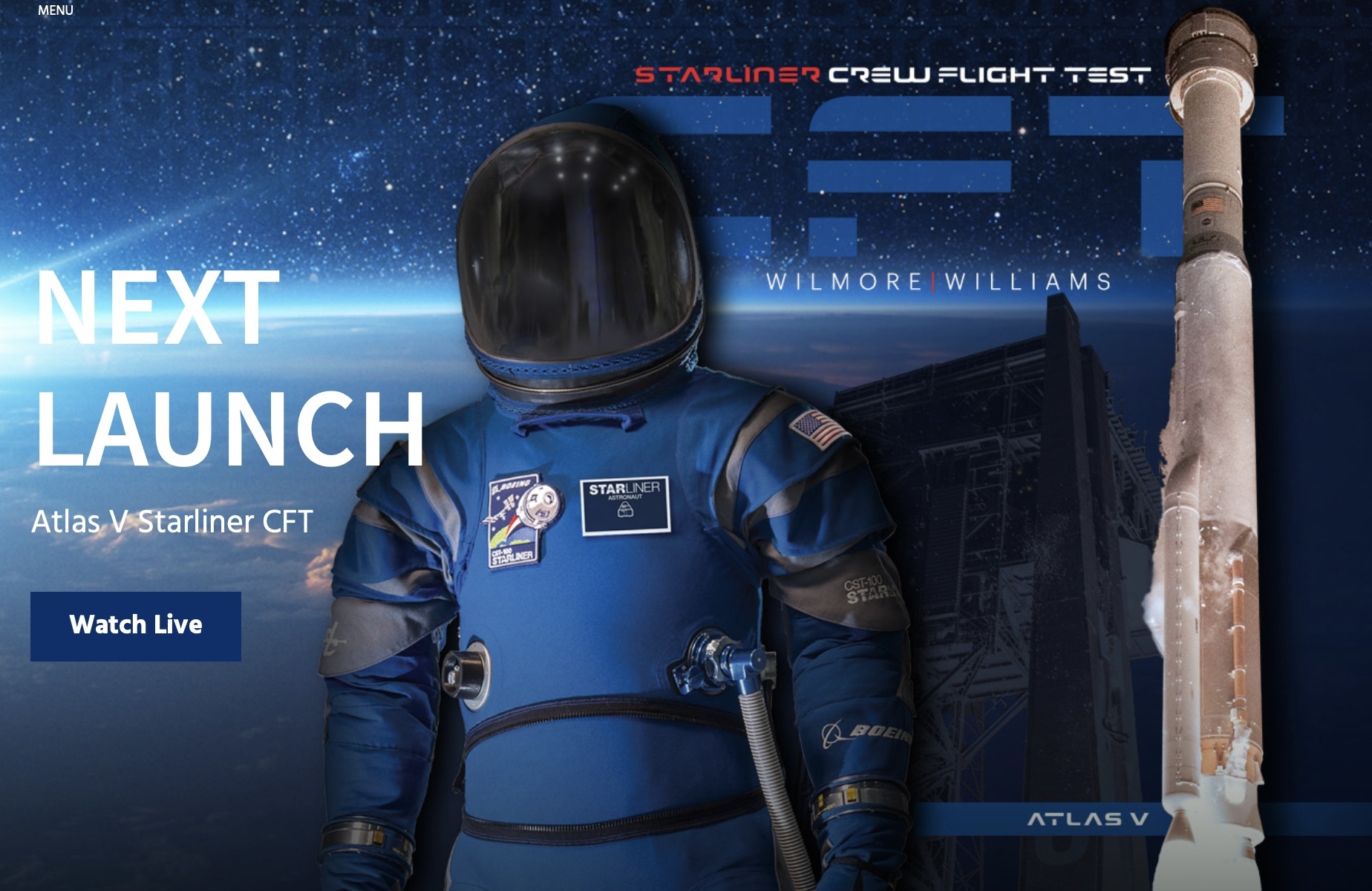
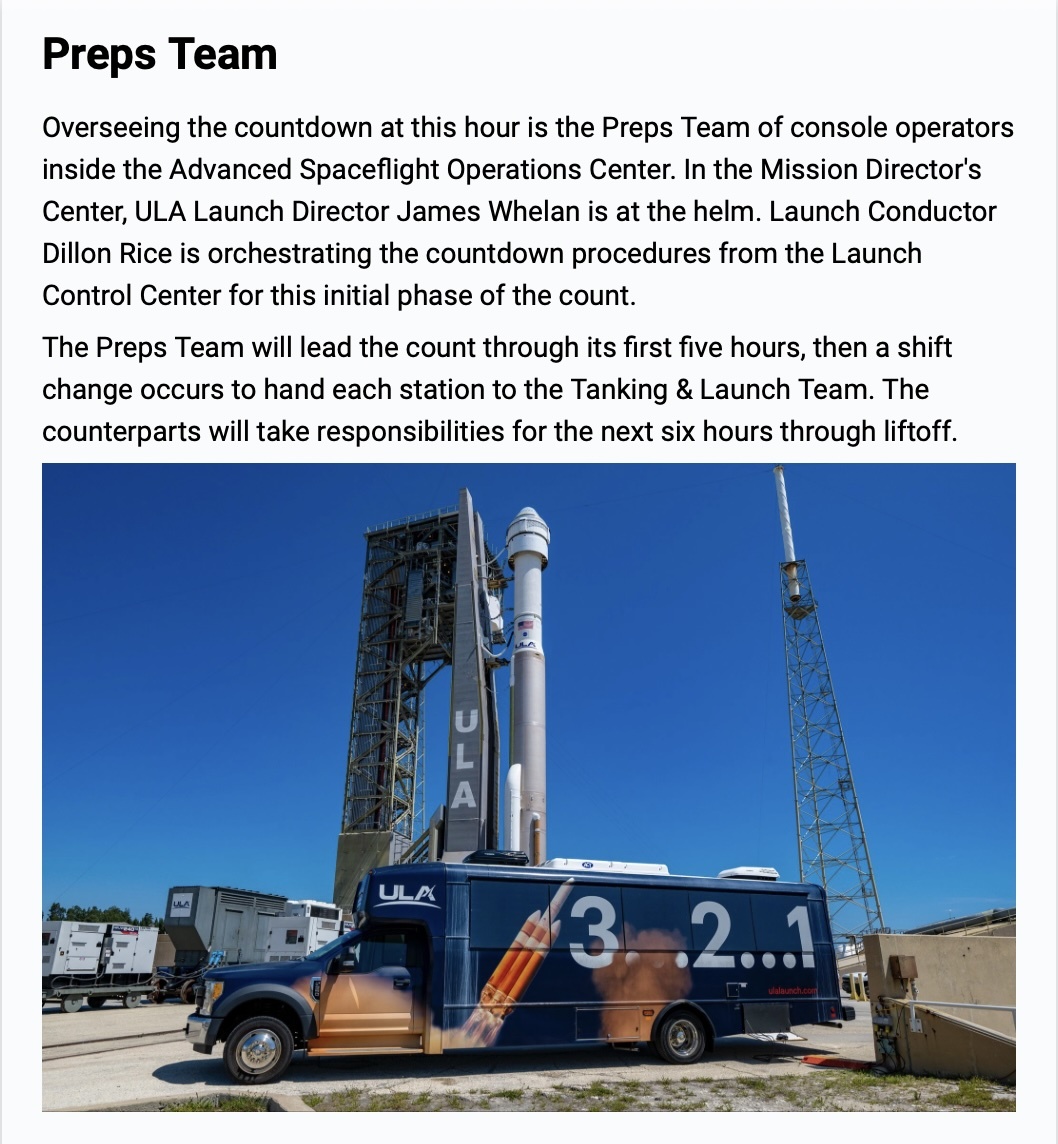

Quelle: ULA
